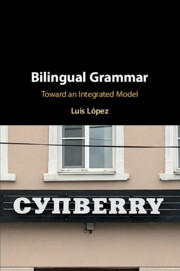Book contents
- Bilingual Grammar
- Bilingual Grammar
- Copyright page
- Contents
- Figures
- Acknowledgments
- 1 Introduction: Motivating a Unified Linguistic System
- 2 Remarks on Separationist Architectures
- 3 Phases, Distributed Morphology, and Some Contributions from Code-Switching
- 4 1Lex in MDM
- 5 Building the Case for 1Lex: Gender in Code-Switching
- 6 1PF in MDM
- 7 Lexical Questions: What Do You Learn When You Learn a Word?
- 8 Psycho-Syntactic Questions: Acquisition, Priming and Co-activation, and a Note on Processing Cost
- 9 Convergent and Divergent Paths
- 10 General Conclusions
- Book part
- Notes
- References
- Index
4 - 1Lex in MDM
Published online by Cambridge University Press: 02 May 2020
- Bilingual Grammar
- Bilingual Grammar
- Copyright page
- Contents
- Figures
- Acknowledgments
- 1 Introduction: Motivating a Unified Linguistic System
- 2 Remarks on Separationist Architectures
- 3 Phases, Distributed Morphology, and Some Contributions from Code-Switching
- 4 1Lex in MDM
- 5 Building the Case for 1Lex: Gender in Code-Switching
- 6 1PF in MDM
- 7 Lexical Questions: What Do You Learn When You Learn a Word?
- 8 Psycho-Syntactic Questions: Acquisition, Priming and Co-activation, and a Note on Processing Cost
- 9 Convergent and Divergent Paths
- 10 General Conclusions
- Book part
- Notes
- References
- Index
Summary
This chapter makes an initial presentation of the 1Lex hypothesis. It is shown that the mixed selection and noun class puzzles disappear if there is only one lexicon. It is followed with a discussion of how the lexicon of a biingual must be organized and the possibility of competition at the vocabulary insertion point. It also explores some of the consequences of the hypothesis for our understanding of borrowing, loan translation, and syntactic transfer.
Keywords
- Type
- Chapter
- Information
- Bilingual GrammarToward an Integrated Model, pp. 46 - 75Publisher: Cambridge University PressPrint publication year: 2020

